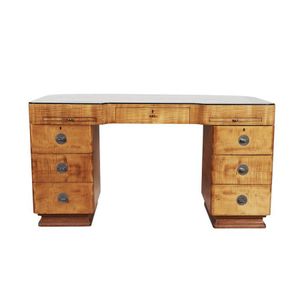1930s Art Deco Double Pedestal Desk with Sycamore Veneer
You must be a subscriber, and be logged in to view price and dealer details.
Subscribe Now to view actual auction price for this item
When you subscribe, you have the option of setting the currency in which to display prices to $Au, $US, $NZ or Stg.
- Pedestal Desk - A pedestal desk is a type of desk that consists of a large work surface supported by two pedestals or cabinets, one on either side. The pedestals are usually identical and contain drawers and cabinets for storage. The desk's design allows it to be placed in the centre of a room, as the back of the desk is usually finished with the same veneer as the front.
Pedestal desks were popular in the 18th and 19th centuries, and were usually made from high-quality wood, such as cedar, mahogany, walnut or oak, and were decorated with intricate carvings and other decorative details. They were used by businessmen, politicians, and other professionals, and were considered a symbol of status and success. - Veneers - Veneers are thin sheets of well-figured timber that are glued under pressure to the surface of a cheaper timber for decorative effect, and then used in the making of carcase furniture.
Early veneers were saw-cut so were relatively thick, (up to 2 mm) but is was realised that saw cutting was wasteful, as timber to the equivilent of the thickness of the saw was lot on each cut.
A more efficient method was devised to slice the timber, either horizontally with a knife, or in a rotary lathe.
Flame veneer, commonly found in mahogany or cedar furniture, is cut from the junction of the branches and main trunk. So-called fiddleback veneers, where the grain is crossed by a series of pronounced darker lines, is usually cut from the outer sections of the tree trunk.
During the 17th and 18th centuries, and in much of the walnut marquetry furniture made during the latter part of the 19th century, the veneer was laid in quarters, each of the same grain, so that one half of the surface was the mirror image of the other.
The use of veneer allows many other decorative effects to be employed, including stringing, feather banding, cross banding, and inlaid decorative panels in the piece. The carcase over which veneer is laid is usually of cheaper timber such as pine, oak or, sometimes in Australia during the first half of the 19th century, red cedar.
The important thing to remember about veneers is that prior to about 1850 they were cut by hand, and were consequently quite thick - ranging up to about 2mm deep.
From the mid-19th century veneers were cut by machines and were almost wafer-thin. This is a critical point when trying to judge the approximate age of veneered furniture. - Art Deco Period - The Art Deco period was a cultural movement that emerged in the 1920s and 1930s, and was characterized by its emphasis on modernism, luxury, and elegance. The name "Art Deco" comes from the Exposition Internationale des Arts Décoratifs et Industriels Modernes, a large exhibition held in Paris in 1925 that showcased the latest trends in decorative arts.
Art Deco was a reaction against the ornate and elaborate styles of the previous era, and reflected a new modern sensibility. It was characterized by streamlined, geometric shapes, bright colours, and the use of new materials such as chrome, glass, and Bakelite. Art Deco designers sought to create a sense of luxury and sophistication, often incorporating expensive materials such as ivory, marble, and rare woods.
Art Deco had a significant impact on a wide range of artistic fields, including architecture, fashion, graphic design, and interior design. Some of the most iconic examples of Art Deco architecture include the Empire State Building in New York City, the Hoover Building in London, and the Palais de Chaillot in Paris.
The Art Deco period came to an end in the 1940s, as World War II and changing cultural trends led to a shift in artistic styles. However, Art Deco remains an important influence on design and art, and continues to be celebrated for its modernist sensibility and glamorous aesthetic. - Pedestal - The columns that support many dining tables and most small occasional tables. They are usually turned, though octagonal-shaped pedestals were fashionable during the 1830s and 1840s.
- Amaranth / Purpleheart / Palisander - Amaranth, also called "purpleheart" and palisander is a hardwood obtained flowering plants in tropical regions of Central and South America, where they grow in rainforests. When the trees are cut, the timber turns from a dark brown to a rich purple colour. It is mainly used for veneering and decorative features on furniture, and is extremely dense when dry.
This item has been included into following indexes:
- desks, period or age - Art Deco 36
- desks, style or type
Visually similar items

Victorian mahogany kneehole desk with tooled inset red leather top, three frieze drawers, three drawers to pedestals on box bases

An early 20th century pedestal desk with a leather inset top, includes eight drawers and a central drawer, 75 cm high by 137 cm long, and 76 cm deep

A substantial leather inset mahogany partners desk, early 20th century 77 cm high, 205 cm wide, 108 cm deep

A twin pedestal cedar partners desk, leather inlayed top over nine drawers, 74 x 154 x 105 cm
